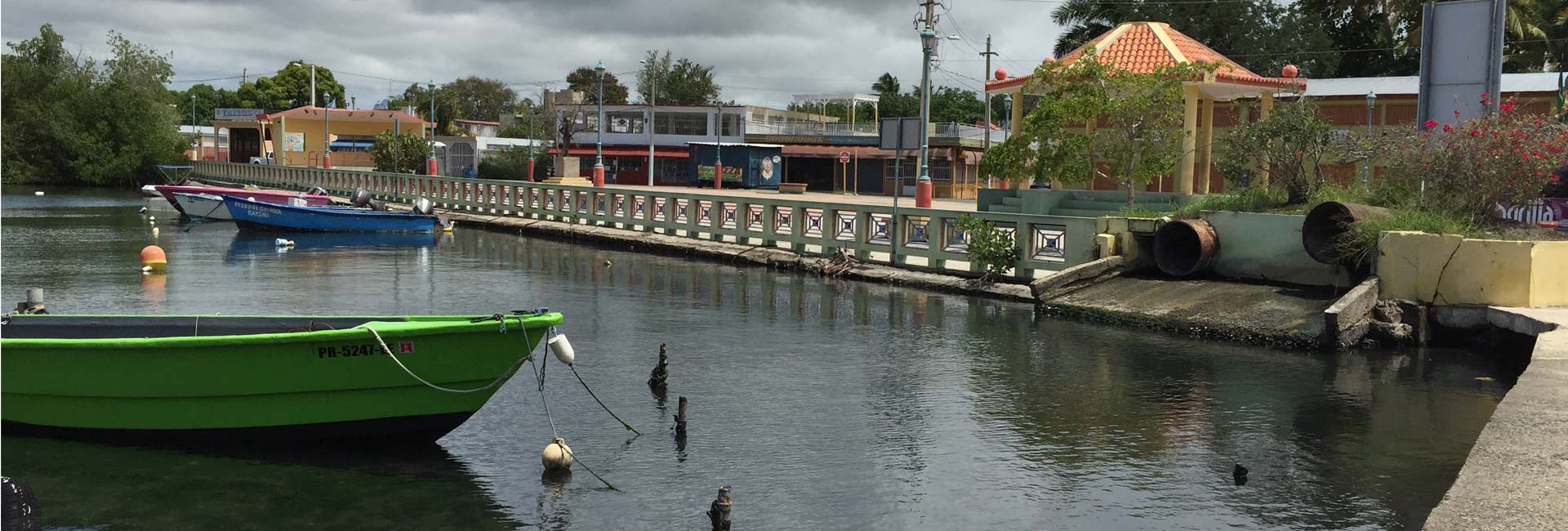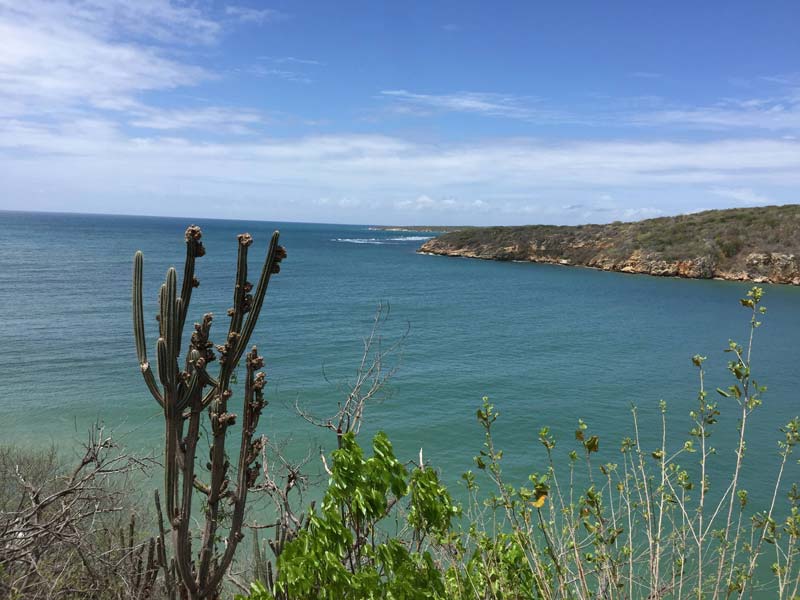



Miller School researcher records the second-highest levels of PCBs anywhere in the world.
Angry and apathetic, the group of local anglers greeted Daisy Ramirez Ortiz with a wave of unwelcoming stares. They already knew why the University of Miami public health sciences student had asked to meet with them, and they weren’t interested at all in what she had to say:
Dangerously high levels of a poisonous chemical called polychlorinated biphenyls, or PCBs, had been found not only in the sediment of Puerto Rico’s Guánica Bay but also in some of the fish that inhabit the inlet.
“That’s not important to us,” one of the fishermen would say. “We need to catch and sell fish to make a living.”
Despite the resistance she encountered, Ortiz pressed on, telling the group that overexposure to the toxic chemical could lead to serious health problems, from immune, reproductive, and nervous system disorders to cardio and cerebrovascular disease.
If Ortiz’s warning frightened the anglers, then she had accomplished one of her goals: to make them aware of the gravity of the situation.
“We’re talking about extremely hazardous levels, the second-highest concentrations ever recorded worldwide,” says Naresh Kumar, an associate professor of environmental health in the Miller School of Medicine’s Department of Public Health Sciences and the lead investigator of the study that identified the elevated levels of PCBs.
About the Photo
Guánica Bay, located on Puerto Rico’s southwestern coast, is being investigated for high levels of polychlorinated biphenyls, or PCBs, which have been found in sediment and fish. Photo credit: Naresh Kumar
Join the Conversation:
Follow on
Twitter:
UM Miller School of Medicine, @umiamimedicine
UM College
of Engineering, @UMCoEDean
University of
Miami, @univmiami
UM News, @univmiaminews
A group of man-made organic chemicals, PCBs have been used as coolants and lubricants in transformers, capacitors, and other electrical equipment because they don’t burn easily and are excellent insulators. The chemicals were banned in the U.S. in 1979 amid evidence they build up in the environment and pose a threat to human health.
But while it’s been nearly four decades since PCBs were banned, the chemicals have endured, making their way into the environment via poorly maintained hazardous waste sites, illegal or improper dumping of PCB wastes, leaks from old transformers that contain the chemical, and the disposal of PCB-containing consumer products into municipal or other landfills that were not designed to accommodate hazardous waste.

“In places like Guánica that lack the resources to effectively test for contaminants, PCBs can be a major threat to community health,” says Kumar.
In 2013 and 2014, he collected sediment samples from three sites in Guánica Bay and tested them in the lab, discovering PCB levels second only to those found in Canada’s St. Lawrence River in 1995. High levels of PCB’s also were found in two species of fish—a mutton snapper and common mojarra—caught in the bay.
“What we found so interesting about this site (Guánica Bay) is that it’s a marine environment, and it’s very rare to find this level of contamination in such a habitat. Usually it’s found more in rivers, where the water is not as diluted,” says Helena Solo-Gabriele, professor and associate dean for research in the College of Engineering’s Department of Civil, Architectural and Environmental Engineering and collaborator on Kumar’s study.
While pollutants from sugar mills, fertilizer plants, textile companies, and coffee plantations have all discharged into Puerto Rico’s Río Loco River, which feeds into the bay, researchers can’t say for certain just what caused the high levels of PCBs in the water because they lack solid evidence to implicate industry, says Kumar, noting that several oil spills have also occurred in the bay.

What’s clear to Kumar, though, is that PCBs are a real threat, with one of the most common exposure routes to humans being through food like fish. And in the town of Guánica, fishing is an important line of work and source of income, with almost 5 percent the population listing the activity, along with agriculture, as their primary occupation.
That’s one of the reasons Ortiz, then a graduate student in Kumar’s lab, met with local anglers three years ago—to bring them up to speed on her mentor’s PCB contamination study, even though some of them felt it threatened their livelihood. But it wasn’t her intention to just scare them. The Puerto Rican-born Ortiz, who grew up only an hour away from Guánica and would sometimes go boating on its scenic bay, wanted the anglers to know that she and Kumar were also there to help.
That assistance would come in the form of a community partnership initiated by Kumar as part of his study. The Miller School researcher contacted school officials at Guánica’s Aurea E. Quiles Claudio High School in 2014, asking them if they would be interested in having their students participate in a campaign aimed at raising community awareness about PCB contamination in the bay.
They agreed, and what followed was a project in which students created informational posters on PCB contamination rates in the bay and the potential impacts the chemicals could have on human health and the environment.
“The project started with 25 students, but quickly spread throughout the school,” says Glenda Almodovar, a former biology teacher at the school who supervised the poster campaign. “The goal was to educate students so that they would take the message home to their parents and neighbors.”
Spots on local radio shows, in which Ortiz was interviewed about PCBs and how residents could reduce their exposure to them, were also part of the public awareness campaign.
Months have passed since that campaign, and still, more needs to be done, namely continued education and research, says Kumar.
He would like to see Guánica Bay designated as a Superfund site, any area in the United States and its territories contaminated by hazardous waste and placed on the National Priorities List by the Environmental Protection Agency (EPA) for cleanup because it poses a risk to human health and the environment.
Kumar feels he has a strong case, with the findings of a federal scientific agency to support his research. Shortly before he initiated his study, scientists from the National Oceanic and Atmospheric Administration (NOAA) also tested sediment from the bay, coming up with PCB levels consistent with those that would subsequently be recorded by Kumar.
But his wish to see Guánica Bay attain Superfund status may never happen, as the EPA has already ruled the site doesn’t qualify as one.
“Following the completion of NOAA’s study in 2014, the EPA conducted an evaluation of PCBs in Guánica Bay. After no source of the contamination could be identified, and after it was determined that no exposure pathways for humans were present, the site was not recommended to the National Priorities List,” EPA spokesperson John Martin says in an email after UM’s University Communications division contacted the agency for comment.
Kumar strongly disagrees with that statement, saying an exposure pathway, in fact, does exist. “Our research suggests children do swim in the bay and that people harvest fish from it,” says Kumar. “We’ve shown PCB levels in fish higher than the FDA limit, so there is a natural link to human exposure.”
He also points out that PCB levels in the bay are much higher than those found at and around many existing Superfund sites.
Kumar plans to apply for grants to investigate the impact of PCBs on Guánica residents.
Though not targeted at Guánica, research is already underway to determine the chemicals’ potential impact on humans. Using mice as test subjects, M.D./Ph.D. candidate Mathew C. Phillips is conducting research on how PCBs affect the gut and intestines.
“Earlier research has shown that when mice are exposed to PCBs, their guts tend to become leaky. Stuff from inside the intestine, specifically bacteria and their products, start to leak, and this is actually a big issue,” says Phillips, who works out of the lab of Maria T. Abreu, chief of the Division of Gastroenterology and professor of medicine. “The most incredible thing about the gut is how it compartmentalizes substances that, if they’re in any other part of the body, wreak havoc. So whenever you have a substance like PCBs that’s interfering with the barrier function of the gut, it has the potential to cause very wide-ranging, negative effects.”
Kumar says the PCB contamination problem in Guánica Bay is just as important as the water crisis in Flint, Michigan, where residents were exposed to elevated levels of lead after the decision was made to start using the highly contaminated Flint River as the city’s main water source.
“The problem in Guánica isn’t going away,” says Kumar. “Unfortunately, it sometimes takes the problem becoming a political issue until action is taken.”
For marginalized communities like Guánica, says Kumar, where more than 60 percent of families live below the federal poverty level and the median household income is barely above $13,000, that may be too late.
- ROBERT C. JONES JR. / UM News
